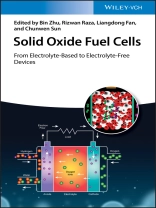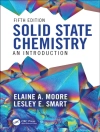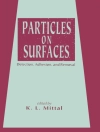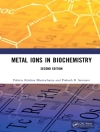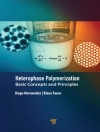Presents innovative approaches towards affordable, highly efficient, and reliable sustainable energy systems
Written by leading experts on the subject, this book provides not only a basic introduction and understanding of conventional fuel cell principle, but also an updated view of the most recent developments in this field. It focuses on the new energy conversion technologies based on both electrolyte and electrolyte-free fuel cells?from advanced novel ceria-based composite electrolyte low temperature solid oxide fuel cells to non-electrolyte fuel cells as advanced fuel-to-electricity conversion technology.
Solid Oxide Fuel Cells: From Electrolyte-Based to Electrolyte-Free Devices is divided into three parts. Part I covers the latest developments of anode, electrolyte, and cathode materials as well as the SOFC technologies. Part II discusses the non-electrolyte or semiconductor-based membrane fuel cells. Part III focuses on engineering efforts on materials, technology, devices and stack developments, and looks at various applications and new opportunities of SOFC using both the electrolyte and non-electrolyte principles, including integrated fuel cell systems with electrolysis, solar energy, and more.
-Offers knowledge on how to realize highly efficient fuel cells with novel device structures
-Shows the opportunity to transform the future fuel cell markets and the possibility to commercialize fuel cells in an extended range of applications
-Presents a unique collection of contributions on the development of solid oxide fuel cells from electrolyte based to non-electrolyte-based technology
-Provides a more comprehensive understanding of the advances in fuel cells and bridges the knowledge from traditional SOFC to the new concept
-Allows readers to track the development from the conventional SOFC to the non-electrolyte or single-component fuel cell
Solid Oxide Fuel Cells: From Electrolyte-Based to Electrolyte-Free Devices will serve as an important reference work to students, scientists, engineers, researchers, and technology developers in the fuel cell field.
Spis treści
Preface xiii
Part I Solid Oxide Fuel Cell with Ionic Conducting Electrolyte 1
1 Introduction 3
Bin Zhu and Peter D. Lund
1.1 An Introduction to the Principles of Fuel Cells 3
1.2 Materials and Technologies 5
1.3 New Electrolyte Developments on LTSOFC 10
1.4 Beyond the State of the Art: The Electrolyte-Free Fuel Cell (EFFC) 20
1.4.1 Fundamental Issues 23
1.5 Beyond the SOFC 25
References 28
2 Solid-State Electrolytes for SOFC 35
Liangdong Fan
2.1 Introduction 35
2.2 Single-Phase SOFC Electrolytes 37
2.2.1 Oxygen Ionic Conducting Electrolyte 37
2.2.1.1 Stabilized Zirconia 37
2.2.1.2 Doped Ceria 39
2.2.1.3 Sr O- and Mg O-Doped Lanthanum Gallates (LSGM) 42
2.2.2 Proton-Conducting Electrolyte and Mixed Ionic Conducting Electrolyte 42
2.2.3 Alternative New Electrolytes and Research Interests 44
2.3 Ion Conduction/Transportation in Electrolytes 49
2.4 Composite Electrolytes 52
2.4.1 Oxide–Oxide Electrolyte 52
2.4.2 Oxide–Carbonate Composite 53
2.4.2.1 Materials Fabrication 54
2.4.2.2 Performance and Stability Optimization 57
2.4.3 Other Oxide–Salt Composite Electrolytes 60
2.4.4 Ionic Conduction Mechanism Studies of Ceria–Carbonate Composite 62
2.5 NANOCOFC and Material Design Principle 66
2.6 Concluding Remarks 67
Acknowledgments 69
References 69
3 Cathodes for Solid Oxide Fuel Cell 79
Tianmin He, Qingjun Zhou, and Fangjun Jin
3.1 Introduction 79
3.2 Overview of Cathode Reaction Mechanism 80
3.3 Development of Cathode Materials 82
3.3.1 Perovskite Cathode Materials 82
3.3.1.1 Mn-Based Perovskite Cathodes 83
3.3.1.2 Co-Based Perovskite Cathodes 85
3.3.1.3 Fe-Based Perovskite Cathodes 88
3.3.1.4 Ni-Based Perovskite Cathodes 89
3.3.2 Double Perovskite Cathode Materials 89
3.4 Microstructure Optimization of Cathode Materials 94
3.4.1 Nanostructured Cathodes 94
3.4.2 Composite Cathodes 97
3.5 Summary 102
References 103
4 Anodes for Solid Oxide Fuel Cell 113
Chunwen Sun
4.1 Introduction 113
4.2 Overview of Anode Reaction Mechanism 114
4.2.1 Basic Operating Principles of a SOFC 114
4.2.1.1 The Anode Three-Phase Boundary 115
4.3 Development of Anode Materials 117
4.3.1 Ni–YSZ Cermet Anode Materials 117
4.3.2 Alternative Anode Materials 118
4.3.2.1 Fluorite Anode Materials 118
4.3.2.2 Perovskite Anode Materials 120
4.3.3 Sulfur-Tolerant Anode Materials 124
4.4 Development of Kinetics, Reaction Mechanism, and Model of the Anode 126
4.5 Summary and Outlook 135
Acknowledgments 137
References 137
5 Design and Development of SOFC Stacks 145
Wanbing Guan
5.1 Introduction 145
5.2 Change of Cell Output Performance Under 2D Interface Contact 145
5.2.1 Design of 2D Interface Contact Mode 145
5.2.2 Variations of Cell Output Performance Under 2D Contact Mode 147
5.2.3 2D Interface Structure Improvements and Enhancement of Cell Output Performance 149
5.2.4 Contributions of 3D Contact in 2D Interface Contact 151
5.2.5 Mechanism of Performance Enhancement After the Transition from 2D to 3D Interface 153
5.3 Control Design of Transition from 2D to 3D Interface Contact and Their Quantitative Contribution Differentiation 156
5.3.1 Control Design of 2D and 3D Interface Contact 156
5.3.2 Quantitative Effects of 2D Contact on the Transient Output Performance of a Cell 158
5.3.3 Quantitative Effects of 2D Contact on the Steady-State Output Performance of the Cell 161
5.3.4 Quantitative Effects of 3D Contact on Cell Transient Performance 163
5.3.5 Quantitative Effects of 3D Contact on the Steady-State Performance of a Cell 166
5.3.6 Differences Between 2D and 3D Interface Contacts 169
5.4 Conclusions 171
References 172
Part II Electrolyte-Free Fuel Cells: Materials, Technologies, and Working Principles 173
6 Electrolyte-Free SOFCs: Materials, Technologies, and Working Principles 175
Bin Zhu, Liangdong Fan, Jung-Sik Kim, and Peter D. Lund
6.1 Concept of the Electrolyte-Free Fuel Cell 175
6.2 SLFC Using the Ionic Conductor-based Electrolyte 177
6.3 Developments on Advanced SLFC 179
6.4 From SLFCs to Semiconductor–Ionic Fuel Cells (SIFCs) 184
6.5 The SLFC Working Principle 196
6.6 Remarks 204
Acknowledgments 207
References 207
7 Ceria Fluorite Electrolytes from Ionic to Mixed Electronic and Ionic Membranes 213
Baoyuan Wang, Liangdong Fan, Yanyan Liu, and Bin Zhu
7.1 Introduction 213
7.2 Doped Ceria as the Electrolyte for Intermediate Temperature SOFCs 214
7.3 Surface Doping for Low Temperature SOFCs 216
7.4 Non-doped Ceria for Advanced Low Temperature SOFCs 222
References 235
8 Charge Transfer in Oxide Solid Fuel Cells 239
Jing Shi and Sining Yun
8.1 Oxygen Diffusion in Perovskite Oxides 239
8.1.1 Oxygen Vacancy Formation 239
8.1.2 Oxygen Diffusion Mechanisms 242
8.1.3 Anisotropy Oxygen Transport in Layered Perovskites 244
8.1.3.1 Oxygen Transport in Ruddlesden–Popper (RP) Perovskites 244
8.1.3.2 Oxygen Transport in A-Site Ordered Double Perovskites 244
8.1.4 Oxygen Ion Diffusion at Grain Boundary 246
8.1.5 Factors Controlling Oxygen Migration Barriers in Perovskites 248
8.2 Proton Diffusion in Perovskite-Type Oxides 249
8.2.1 Proton Diffusion Mechanisms 249
8.2.2 Proton–Dopant Interaction 253
8.2.2.1 Influence of Dopants in A-site 253
8.2.2.2 Influence of Dopants in B-Site 254
8.2.3 Long-range Proton Conduction Pathways in Perovskites 255
8.2.4 Hydrogen-Induced Insulation 256
8.3 Enhanced Ion Conductivity in Oxide Heterostructures 259
8.3.1 Enhanced Ionic Conduction by Strain 259
8.3.2 Enhanced Ionic Conductivity by Band Bending 263
8.3.2.1 Surface State-induced Band Bending 263
8.3.2.2 Band Bending in p–n Heterojunctions 265
8.3.2.3 p–n Heterojunction Structures in SOFC 265
8.4 Summary 266
Acknowledgments 267
References 267
9 Material Development II: Natural Material-based Composites for Electrolyte Layer-free Fuel Cells 275
Chen Xia and Yanyan Liu
9.1 Introduction 275
9.1.1 Materials Development for EFFCs 275
9.1.2 Natural Materials as Potential Electrolytes 276
9.2 Industrial-grade Rare Earth for EFFCs 279
9.2.1 Rare-earth Oxide LCP 280
9.2.2 Semiconducting–Ionic Composite Based on LCP 281
9.2.2.1 LCP–LSCF 282
9.2.2.2 LCP–Zn O 284
9.2.3 Stability Operation and Schottky Junction of EFFC 288
9.2.3.1 Performance Stability 288
9.2.3.2 In Situ Schottky Junction Effect 288
9.2.4 Summary 290
9.3 Natural Hematite for EFFCs 291
9.3.1 Natural Hematite 292
9.3.2 Semiconducting–Ionic Composite Based on Hematite 295
9.3.2.1 Hematite–LSCF 295
9.3.2.2 Hematite/LCP–LSCF 297
9.3.3 Summary 300
9.4 Natural Cu Fe Oxide Minerals for EFFCs 302
9.4.1 Natural Cu Fe2O4 Mineral for EFFC 302
9.4.2 Natural Delafossite Cu Fe O2 for EFFC 305
9.4.3 Summary 308
9.5 Bio-derived Calcite for EFFC 308
9.5.1 Bio-derived Calcite for EFFC 309
9.5.2 Summary 312
References 314
10 Charge Transfer, Transportation, and Simulation 319
Muhammad Afzal, Mustafa Anwar, Muhammad I. Asghar, Peter D. Lund, Naveed Jhamat, Rizwan Raza, and Bin Zhu
10.1 Physical Aspects 319
10.2 Electrochemical Aspects 320
10.3 Ionic Conduction Enhancement in Heterostructure Composites 321
10.4 Charge Transportation Mechanism and Coupling Effects 326
10.5 Surface and Interfacial State-Induced Superionic Conduction and Transportation 330
10.6 Ionic Transport Number Measurements 331
10.7 Determination of Electron and Ionic Conductivities in EFFCs 332
10.8 EIS Analysis 334
10.9 Semiconductor Band Effects on the Ionic Conduction Device Performance 335
10.10 Simulations 339
Acknowledgments 343
References 343
11 Electrolyte-Free Fuel Cell: Principles and Crosslink Research 347
Yan Wu, Liangdong Fan, Naveed Mushtaq, Bin Zhu, Muhammad Afzal, Muhammad Sajid, Rizwan Raza, Jung-Sik Kim, Wen-Feng Lin, and Peter D. Lund
11.1 Introduction 347
11.2 Fundamental Considerations of Fuel Cell Semiconductor Electrochemistry 353
11.2.1 Physics and Electrochemistry at Interfaces 353
11.2.2 Electrochemistry vs. Semiconductor Physics 355
11.3 Working Principle of Semiconductor-Based Fuel Cells and Crossing Link Sciences 356
11.4 Extending Applications by Coupling Devices 367
11.5 Final Remarks 368
Acknowledgments 372
References 373
Part III Fuel Cells: From Technology to Applications 377
12 Scaling Up Materials and Technology for SLFC 379
Kang Yuan, Zhigang Zhu, Muhammad Afzal, and Bin Zhu
12.1 Single-Layer Fuel Cell (SLFC) Engineering Materials 379
12.2 Scaling Up Single-Layer Fuel Cell Devices: Tape Casting and Hot Pressing 383
12.3 Scaling Up Single-Layer Fuel Cell Devices: Thermal Spray Coating Technology 386
12.3.1 Traditional Plasma Spray Coating Technology 387
12.3.2 New Developed Low-Pressure Plasma Spray (LPPS) Coating Technology 388
12.4 Short Stack 395
12.4.1 SLFC Cells 395
12.4.2 Bipolar Plate Design 396
12.4.3 Sealing and Sealant-Free Short Stack 396
12.5 Tests and Evaluations 397
12.6 Durability Testing 399
12.7 A Case Study for the Cell Degradation Mechanism 400
12.8 Continuous Efforts and Future Developments 404
12.9 Concluding Remarks 409
References 411
13 Planar SOFC Stack Design and Development 415
Shaorong Wang, Yixiang Shi, Naveed Mushtaq, and Bin Zhu
13.1 Internal Manifold and External Manifold 415
13.2 Interface Between an Interconnect Plate and a Single Cell 416
13.3 Antioxidation Coating of the Interconnect Plate 418
13.4 Design the Flow Field of Interconnect Plate 419
13.4.1 Mathematical Simulation 420
13.4.2 Effect of Co-flow, Crossflow, and Counterflow 422
13.4.3 Air Flow Distribution Between Layers in a Stack 424
13.5 The Importance of Sealing 424
13.5.1 Thermal Cycling of the Sealing 428
13.5.2 Durability of Sealing 428
13.6 The Life of the Stack: The Chemical Problems on the Interface 429
13.7 Toward Market Products 431
13.8 Concluding Remarks 443
References 443
14 Energy System Integration and Future Perspectives 447
Ghazanfar Abbas, Muhammad Ali Babar, Fida Hussain, and Rizwan Raza
14.1 Solar Cell and Fuel Cell 447
14.2 Fuel Cell–Solar Cell Integration 450
14.3 Solar Electrolysis–Fuel Cell Integration 452
14.4 Fuel Cell–Biomass Integration 453
14.5 The Fuel Cell System Modeling Using Biogas 454
14.5.1 Activation Loss 457
14.5.2 Ohmic Loss 457
14.5.3 Concentration Voltage Loss 458
14.6 The Fuel Cell System Efficiency (Heating and Electrical) 458
14.6.1 The Effect of Different Temperatures on System Efficiency 458
14.6.2 The Fuel Utilization Factor and Efficiencies of the System 458
14.6.3 The System Efficiencies and Operating Pressure 460
14.7 Integrated New Clean Energy System 460
14.8 Summary 462
References 462
Index 465
O autorze
Bin Zhu, Ph D, moved from KTH, Sweden as a Chief Scientist (Professor Director) of Energy Storage Joint Research Center, Southeast University, China. He has published more than 300 scientifc papers in nano-composite ionic conductors and new semiconductor-ionic materials for advanced fuel cells.
Rizwan Raza, Ph D, is Assistant Professor in the Department of Physics in COMSATS Institute of Information Technology, Pakistan. He has published more than 100 scientific papers.
Liangdong Fan, Ph D, is Lecturer in the College of Chemistry and Environmental Engineering at Shenzhen University, China. His interests focus on novel nanocomposite functional materials for fuel cells and electro-catalysis.
Chunwen Sun is a Professor at Beijing Institute of Nanoenergy and Nanosystems (BINN), Chinese Academy of Sciences (CAS). His research interests include energy storage and conversion, e.g., lithium/sodium-ion batteries, metal-air batteries, all-solid-state batteries, fuel cells and self-power systems.
